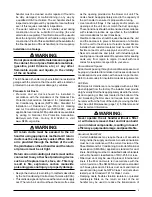
5
handler must be cleaned and/or repaired if found to
be dirty, damaged, or malfunctioning in any way by
a qualified HVAC technician. The air handler shall be
inspected and approved by applicable local authority
even if this requires redundant inspections.
• The serial number for the air handler used during
construction must be submitted in writing (fax and
email also acceptable). This information will be used to
track the long-term affects of air handler usage during
construction. Proof of this submittal shall be available for
the final inspection of the air handler prior to occupancy.
Installation in a Garage
WARNING:
Do not place combustible materials on or against
the cabinet. Do not place flammable materials,
(gasoline, paint thinners, etc.) or any other
flammable vapors and liquids, in the vicinity
of the air handler.
The B5 Series air handler may be installed in a residential
garage with the provision that the unit must be located or
protected to prevent physical damage by vehicles.
as the opening provided on the blower coil unit. The
ducts should be appropriately sized to the capacity of
the air handler to ensure its proper airflow rating.
• Use transition fittings if the supply and/or return air
openings of the unit do not match the duct openings.
These transitions should be dimensioned in accordance
with standard practice as specified in the ASHRAE
recommendations for duct transitions.
• Flexible connectors should be used between the unit
and the ductwork to prevent transmission of vibration
from the unit to the structure. If electric heater kits are
installed, heat resistant material must be used for the
flexible connector at the supply air end of the unit.
• Seal all connections and joints with industrial grade
sealing tape or liquid sealant. Requirements for sealing
ducts vary from region to region. Consult with local
codes for requirements specific to your area.
Unconditioned Spaces
All duct work passing through unconditioned space must
be properly insulated to minimize duct losses and prevent
condensation. Use insulation with an outer vapor barrier.
Refer to local codes for insulation material requirements.
Air Filters
B5 Series Air Handlers are not supplied with an air filter
when shipped from the factory. The installer must provide
a high velocity filter that is appropriately sized to the return
air duct opening or filter rack located in the bottom of the
unit. Accessing the filter does not require tools and can
be removed from the front of the unit by removing the filter
door. See Unit Maintenance (page 14) for filter sizes and
other important information.
WARNING:
Never operate the air handler without a filter
or with doors removed. Dust and lint can build
up on internal components, resulting in loss of
efficiency, equipment damage, and possible fire.
Acoustical Duct Work
•
Certain installations may require the use of acoustical
lining inside the supply duct work. Acoustical insulation
must be in accordance with the current revision of the
Sheet Metal and Air Conditioning Contractors National
Association (SMACNA) application standard for duct
liners. Duct lining must be UL classified batts or blankets
with a fire hazard classification of FHC-25/50 or less.
• Fiber duct work may be used in place of internal duct
liners if the fiber duct work is in accordance with the
current revision of the SMACNA construction standard
on fibrous glass ducts. Fibrous duct work and internal
acoustical lining must be NFPA Class 1 air ducts when
tested per UL Standard 181 for Class 1 ducts.
•
Damping ducts, flexible vibration isolators, or pleated
media-style filters on the return air inlet of the air
handler may be used to reduce the transmission of
Plenums & Air Ducts
•
Plenums and air ducts should be installed in
accordance with the standards of the National Fire
Protection Association Standard for Installation of
Air Conditioning Systems (NFPA 90A), Standard for
Installation of Residence Type Warm Air Heating
and Air Conditioning Systems (NFPA 90B), and all
applicable local codes. NFPA publications are available
by writing to: National Fire Protection Association,
Batterymarch Park, Quincy, ME 02269 or visit
www.NFPA.org online.
WARNING:
All return ducts must be secured to the air
handler using appropriate methods. All return
ducts must be adequately sealed. When return
air is provided through the bottom of the unit,
the joint between the air handler and the return
air plenum must be air tight.
Return air and circulating air ducts must not be
connected to any other heat producing device
such as a fireplace insert, stove, etc. This may
result in fire, explosion, carbon monoxide
poisoning, personal injury, or property damage.
• Design the duct work according to methods described
by the Air Conditioning Contractors of America (ACCA).
•
This unit is designed only for use with a return and supply
duct. The return air duct must have the same free area
Содержание B5BM
Страница 27: ...27...































